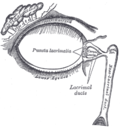| Lacrimal sac | |
|---|---|
 The lacrimal apparatusis shown through dissection on the left side. | |
 The lacrimal sac has been opened showing internal organization as well as the naso-lacrymal duct. | |
| Details | |
| Artery | Angular artery |
| Identifiers | |
| Latin | saccus lacrimalis |
| TA98 | A15.2.07.068 |
| TA2 | 6857 |
| FMA | 20289 |
| Anatomical terminology | |
The lacrimal sac or lachrymal sac [1] is the upper dilated end of the nasolacrimal duct, [2] and is lodged in a deep groove formed by the lacrimal bone and frontal process of the maxilla. It connects the lacrimal canaliculi, which drain tears from the eye's surface, and the nasolacrimal duct, which conveys this fluid into the nasal cavity. [3] Lacrimal sac occlusion leads to dacryocystitis. [4]



